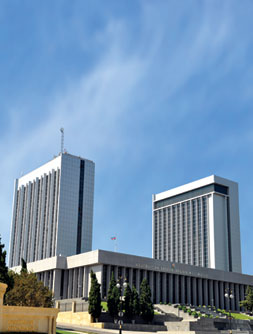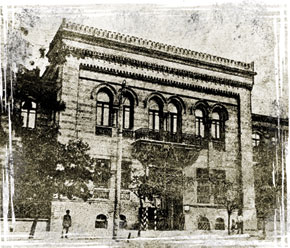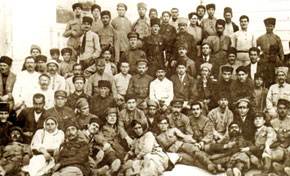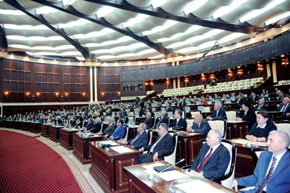Pages 18-23
by Tural Islamov
Members of the Russian State Duma
The history of Azerbaijani parliamentarianism goes back almost to the beginning of the 20th century, to the formation of the first State Duma in Russia. Six members, including Alimardan bey Topchubashov, Mammad Tagi Aliyev and others from the Azerbaijani Muslim population located in Baku, Yelizavetpol (Ganja) and Irevan (the old name for Yerevan) provinces were successful in being elected to the 1st State Duma.
A Muslim faction in the Duma had 36 representatives from different regions of Russia; the Azerbaijani members were the most active. They were critical of the policy of national and religious discrimination pursued by the Russian Empire in the Southern Caucasus and, therefore, defended the interests, not only of Azerbaijanis, but of all Russian Muslims. As the 1st State Duma did not suit the tsarist government it was dissolved in July 1906. In February 1907 a new, 2nd State Duma, was formed. Again six members were elected (Fatali Khan Khoysky, Khalil bey Khasmammadov and others). They were once more active in the Muslim faction. Khoysky and Khasmammadov were elected to the Duma bureau; however, this Duma was also dissolved. The tsarist government toughened the election law in order to produce a more pliable Duma. In the 3rd and 4th Dumas, Azerbaijanis were represented by only one member.
The Transcaucasus Seim
The provisional government acceding to power after the overthrow of the Russian monarchy in February 1917 conducted elections for an Enterprises Assembly in the summer. However, following the Bolshevik October revolution, this government was overthrown.
On 14 February 1918 the Transcaucasian Seim was established in Tbilisi as the supreme government for the Southern Caucasus. The Muslim faction was represented by 44 members in the Enterprises Assembly, winning more than 1 million votes from the Turkic and Muslim populations of Azerbaijan and the South Caucasus. As in the State Dumas, the Azerbaijani members were distinguished by their systematic political activity in the Transcaucasian Seim. It was on their initiative that the Seim declared Transcaucasia’s independence from Russia on 9 April 1918, and the United Republic of Transcaucasia was established.
Independence and a national Council
On 25 May 1918 the Transcaucasian Seim disintegrated, the Muslim faction (which could also be called the Transcaucasian Muslim Parliament) held a separate meeting and decided to declare independence for Azerbaijan. The faction named itself the National Council of Azerbaijan. Thus was the first parliament in the history of Azerbaijan established.
A presidium and chairman were elected at that meeting. Mammad (actually Mahammad) Amin Rasul-Zadeh was chairman of the National Council. On 28 May a Declaration of Independence was adopted at a meeting chaired by Hasan bey Agayev. The Declaration stated: “Azerbaijan is a parliamentary republic and the civil and legal guarantor of all citizens, irrespective of their nationality, religion, social status and gender.” the Declaration of Independence established the first parliamentary republic in the Turkic and Muslim world and, indeed, in the whole East.
The Azerbaijan Democratic Republic (ADR)
At a meeting of the National Council dated 18 November 1918, a resolution to establish a parliament in Azerbaijan was approved. It was decided to summon 80 Muslim Turk representatives, 21 Armenian representatives, 10 Russian representatives and 1 representative of the German, Jewish and other nationalities accordingly.
Thus, on 7 December 1918, the first meeting of the legislative assembly of the first professional parliament in the eastern world, the ADR, was held. This regime continued from 7 December 1918 to 27 April 1920. During this period, 145 meetings of the parliament were held and more than 270 laws were discussed. Approximately 230 of them were passed. The most important laws passed by the Parliament concerned the preservation of the country’s territorial integrity and independence and the building of a democratic state in order to ensure legality and freedom for people.
11 standing committees were active in the parliament. Internal contradictions, an abundance of factions and alignments (there were around 10 factions) hindered the normal functioning of the parliament. As a result the government was changed about four times during the 23 months of the Republic.
However, the parliament approved a whole number of laws concerned with state building. Much work was done to achieve international recognition of the young republic. Owing to the efforts of a delegation headed by parliamentary chairman A.Topchubashov, on 12 January 1920 the main countries participating in the Paris Peace Conference recognised Azerbaijan’s independence. On 22 April, the parliament approved a law to open diplomatic representations in Britain, France, Italy, Sweden, Poland and the USA. These initiatives remained unful- filled due to the occupation of Azerbaijan by Bolshevik Russia.
One of the problems given great attention in the parliament was the regulation of relations with neighbouring countries. After intense discussions, relations with Georgia were resolved and an agreement to establish friendly relations between Iran and Azerbaijan was signed. Dashnak Armenia and Soviet Russia maintained their hostility towards the ADR. The resolution agreed by the parliament on 27 April to transfer power to the Bolsheviks met the interests of these states.
The Soviet era
On 28 April 1920, after the collapse of the national state and its legislative body, the Soviet era began, along with the history of the Soviet parliament in Azerbaijan. These parliaments reflected 70 years of Azerbaijan’s political history, both in their formation and for the facts that their composition and course of work were defined by the Communist Party.
The Revolutionary Committee declared on 29 April 1920 was the first legislative and ruling body established by the Soviets in Azerbaijan. Communists were part of its structure. This was the important element of Moscow’s political tactics. Naturally, real power lay with the party leadership, the Central Committee of the Communist (Bolshevik) Party of Azerbaijan (CC of C(b)PA) being the local organization of the C(b)PR, more precisely, power really lay with the Baku bureau headed by Russians and Armenians (Mikoyan, Mirzoyan).
To create the illusion of people’s ownership of power, the Bolsheviks began organising a system of representative governmental bodies. On 20 May there were elections to the Baku Soviet. The election procedure was organised in such a way that non-Muslims were the majority in that organisation.
With the inclusion of Azerbaijan into the USSR, organised at the end of 1922, even the formal parliamentary functions were reduced to zero. The General Executive Committee (GEC), where all important decisions were made, was superior to the Transcaucasian GEC, which was superior to the Azerbaijani GEC. By the Constitution of the USSR adopted in 1936, the Transcaucasian Federation was abolished and Azerbaijan became a subject of the USSR as a union republic. According to a document called the Stalin Constitution, a new parliamentary institution was established in the Soviet Union, the Supreme Soviet.
The Constitution of the Azerbaijan SSR, adopted in 1937, also reflected these changes. Elections to the Supreme Soviet were conducted every four years. The ratio of seats to population was defined as 1 member per 12,500 people. The elections were carried out in single member constituencies, in other words by a system of majority voting. As a matter of fact, they were not elections. Only one candidate was nominated for each seat. The numbers of workers, kolkhoz members, office workers, women, young people, unaffiliated members etc. in the parliament were defined by the party leadership. The party leadership also determined the chairmanship of meetings for sessions of the Supreme Council. The sessions were held 2-3 times per year and continued for several days. In other words, this was not a fully functional parliament. The members assembled from season to season, accepted the resolutions and laws proposed and then went away. For the rest of the year, the functions of a legislative body were carried out by the Presidium of the Supreme Council. The chairman of the Presidium was seen as second to the parliamentary and party leader in the government’s hierarchy.
Those elected to the Supreme Soviet of the Azerbaijan SSR, as well as to the Supreme Soviet of the USSR, were mainly people who did not have independent positions and could not defend the interests of Azerbaijan. By instruction of the first convocation of the Supreme Soviet on 7 May 1938, a protocol was confirmed to transfer an area of two thousand hectares from the Gubadli, Kalbajar and Gazakh regions to Armenia.
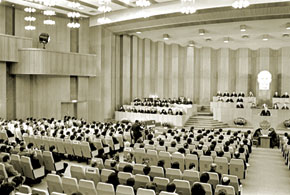 The 1st session of the 10th convocation of the Presidium of the Supreme Soviet of the Azerbaijan SSR and chamber, 1980
The 1st session of the 10th convocation of the Presidium of the Supreme Soviet of the Azerbaijan SSR and chamber, 1980
The last Supreme Soviet, elected in 1990, entered into Azerbaijani history as a legislative body of both Soviet and independent eras. All the political and constitutional decisions on Azerbaijani independence were adopted by this parliament.
On 26 June 1990, at the 12th session of the 11th convocation of the Supreme Soviet, a resolution on “Elections of members of the Azerbaijan SSR” was accepted and elections for a new parliament were fixed for 2 September. There were a number of changes in the new election legislation. First of all, members were to be elected in 360, rather than 450, electoral districts. Membership of the new Supreme Soviet was reduced by 90 seats. On the other hand, the members’ term of office was prolonged by 1 year and the Supreme Soviet was elected not for 4 years, but for 5 years. The most important aspect of the elections was that they offered a choice. Finally, the Soviet election practice, which followed the principle of “1 mandate for 1 candidate” was ended. For the first time, people who opposed the Communist Party had a chance to get into parliament. However these changes were mainly of a formal character. At the same time, the government could not turn a totally deaf ear to the social and political reality existing in the republic. The elections saw the opposition take 30 seats, approximately 8 per cent of the 360-seat parliament.
Independence regained
From the end of 1991, centrifugal tendencies in the USSR intensified. The Supreme Soviet of Azerbaijan held an extraordinary session on 29 August. Members of the opposition proposed the urgent adoption of a resolution on independence. After intense discussions, the declaration “On restoration of state independence for the Republic of Azerbaijan” was adopted unanimously, on 30 August. The resolution stressed that the Republic of Azerbaijan was the successor to the independent state which existed from 1918- 1920. At the same time, as the declaration was a plain document, the Supreme Soviet issued a decision on the drafting and adoption of a Constitutional Act on the independence of Azerbaijan.
On 15 November the Supreme Soviet decided to conduct a referendum on the Constitutional Act “On state independence of the Republic of Azerbaijan”. The referendum was organised for 29 December. On 26 November the Supreme Soviet made a decision to create a National Council consisting of 50 members within the parliament. The Council consisted of a “Democratic bloc” and a “Communist bloc”, each with 25 members, and was the result of a compromise between the government and the opposition. The National Council was created as a temporary structure and was essentially a deliberating body. Resolutions proposed for discussion by the Supreme Soviet first had to pass through this organisation. In fact, the National Council gradually replaced the Supreme Soviet and, from the spring of 1992, began to carry out the functions of the parliament of Azerbaijan. Thus, the last Supreme Soviet elected under the Soviet and communist party regime, as well as standing as an interim government after the declaration of Azerbaijan’s independence, handed over to the “mini parliament” - the National Council - and stepped off the political stage.
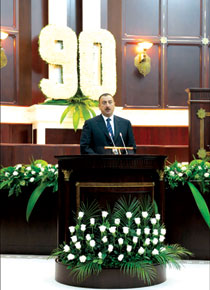 The President of Azerbaijan, Ilham Aliyev, speaking to the formal meeting dedicated to the 90th anniversary of the parliament, 2008
The President of Azerbaijan, Ilham Aliyev, speaking to the formal meeting dedicated to the 90th anniversary of the parliament, 2008
During this period, one of the most important discussions was the 1994 juridicalpolitical assessment of the “20 January” tragedy. Discussions began on 19 January, continued for about two months, with some intervals, and finished on 29 March with the adoption of the comprehensive resolution “About the tragic events perpetrated on 20 January 1990”. At the same time (on 24 February) the parliament adopted a resolution on the Khojaly tragedy. The text of the resolution, considering an annual commemoration of the “Day of the Khojaly genocide” on 26 February was sent to the parliaments of the world and to international organisations.
The Milli Majlis (parliament)
1995 was a decisive year in the development of Azerbaijani statehood. On 12 November, elections were held to the Milli Majlis, along with a referendum on a new Constitution for Azerbaijan. According to electoral law, the parliament consisted of 125 members (100 of them elected proportionally and 25 by majority). As per official results, 86 per cent of electors voted. 92 percent of voters supported the projected Constitution.
After the election of the Milli Majlis, the new membership began to conduct workshops and scientific conferences connected with the formation and development of juridical governmental and non-governmental organisations on a permanent basis. These activities raised issues connected with the protection of the rights of refugees and forced migrants from the Karabagh conflict. Furthermore, women’s rights were also discussed: their participation in government bodies and their role in renewing social and civic legislation. International conventions and UNO documents were translated into the Azerbaijani language. In 1996 foundations were laid for relations between the parliament of Azerbaijan and the Parliament Assembly of the Council of Europe. Azerbaijan gained guest status with PACE and Baku applied officially to enter the CE. In June 2000, Azerbaijan was invited to PACE.
In January 1998, Azerbaijan was the first Muslim country to abolish capital punishment. At that time capital punishment was legal even in some member countries of the CE. In summer 1998, the parliament adopted the law “On the Constitutional Court”. For the first time in Azerbaijan, the highest instance of judicial authority began its work. On 7 August 1998, the censorship imposed on the Azerbaijani press was completely abolished.
In June 2000, intense discussions on the new electoral legislation were held in the Milli Majlis. Elections for its second convocation were held on 5 November 2000.
The history of the new parliament is also rich in terms of legislation and international relations. On 25 January 2001, Azerbaijan became a full member of the CE. According to the fixed quota, 12 seats (6 main seats and 6 reserve seats) in PACE were allocated to Azerbaijan. A group headed by Ilham Aliyev, a member of the Milli Majlis, took part in the work of PACE for the first time. Seats were allocated in the group for representatives of the governing party and for independents, as well as two seats for opposition members.
According to an amendment made to Article 83 of the Constitution, as a result of a referendum held on 24 August 2002, the proportional system of elections to the Milli Majlis was abolished in favour of elections to single-seat electoral districts. Parliamentary powers were also partially extended. Parliament gained the right to elect an Ombudsman (Article 95) and to require an annual report from the government. The number of electoral districts was increased from 100 to 125.
The new Election Code, an important tranche of legislation, was adopted by the parliament in 2003. In general, the provisions of the Election Code were considered acceptable by international experts, including the Venice Committee of the CE.
Parliamentary elections to the third convocation were held in 2005. From 2005- 2010, the Milli Majlis succeeded in creating a new juridical basis in order to introduce international innovations in legal and other fields, as well as international experience, to preserve the national values of the Azerbaijani people. The main issue was the organisation of social protection for the population. Among the other important documents adopted, we may list such laws and resolutions as “The military doctrine of Azerbaijan”, “Protection of human rights”, “Freedom of assembly”, “Concerning the mass media”, “Gender equality”, “Concerning the acceptance of information”.
The latest elections in Azerbaijani parliamentary history were held on 7 November 2010. The active participation of new faces, especially of younger people among the candidates in the elections, can be considered an important step. 741 candidates stood in the elections. This showed increased activity by candidates compared with previous elections. 93 of the candidates were women.
The new parliamentary elections are already part of history. On 29 November 2010, the fourth convocation of the Milli Majlis began its work.
About the author: Tural Islamov is a doctoral candidate of the Department of Azerbaijani History at Baku State University. He is the author of articles on the history of parliamentarianism in Azerbaijan. email: islamovt@gmail.com
by Tural Islamov
Members of the Russian State Duma
The history of Azerbaijani parliamentarianism goes back almost to the beginning of the 20th century, to the formation of the first State Duma in Russia. Six members, including Alimardan bey Topchubashov, Mammad Tagi Aliyev and others from the Azerbaijani Muslim population located in Baku, Yelizavetpol (Ganja) and Irevan (the old name for Yerevan) provinces were successful in being elected to the 1st State Duma.
A Muslim faction in the Duma had 36 representatives from different regions of Russia; the Azerbaijani members were the most active. They were critical of the policy of national and religious discrimination pursued by the Russian Empire in the Southern Caucasus and, therefore, defended the interests, not only of Azerbaijanis, but of all Russian Muslims. As the 1st State Duma did not suit the tsarist government it was dissolved in July 1906. In February 1907 a new, 2nd State Duma, was formed. Again six members were elected (Fatali Khan Khoysky, Khalil bey Khasmammadov and others). They were once more active in the Muslim faction. Khoysky and Khasmammadov were elected to the Duma bureau; however, this Duma was also dissolved. The tsarist government toughened the election law in order to produce a more pliable Duma. In the 3rd and 4th Dumas, Azerbaijanis were represented by only one member.
The Transcaucasus Seim
The provisional government acceding to power after the overthrow of the Russian monarchy in February 1917 conducted elections for an Enterprises Assembly in the summer. However, following the Bolshevik October revolution, this government was overthrown.
On 14 February 1918 the Transcaucasian Seim was established in Tbilisi as the supreme government for the Southern Caucasus. The Muslim faction was represented by 44 members in the Enterprises Assembly, winning more than 1 million votes from the Turkic and Muslim populations of Azerbaijan and the South Caucasus. As in the State Dumas, the Azerbaijani members were distinguished by their systematic political activity in the Transcaucasian Seim. It was on their initiative that the Seim declared Transcaucasia’s independence from Russia on 9 April 1918, and the United Republic of Transcaucasia was established.
Independence and a national Council
On 25 May 1918 the Transcaucasian Seim disintegrated, the Muslim faction (which could also be called the Transcaucasian Muslim Parliament) held a separate meeting and decided to declare independence for Azerbaijan. The faction named itself the National Council of Azerbaijan. Thus was the first parliament in the history of Azerbaijan established.
A presidium and chairman were elected at that meeting. Mammad (actually Mahammad) Amin Rasul-Zadeh was chairman of the National Council. On 28 May a Declaration of Independence was adopted at a meeting chaired by Hasan bey Agayev. The Declaration stated: “Azerbaijan is a parliamentary republic and the civil and legal guarantor of all citizens, irrespective of their nationality, religion, social status and gender.” the Declaration of Independence established the first parliamentary republic in the Turkic and Muslim world and, indeed, in the whole East.
The Azerbaijan Democratic Republic (ADR)
At a meeting of the National Council dated 18 November 1918, a resolution to establish a parliament in Azerbaijan was approved. It was decided to summon 80 Muslim Turk representatives, 21 Armenian representatives, 10 Russian representatives and 1 representative of the German, Jewish and other nationalities accordingly.
Thus, on 7 December 1918, the first meeting of the legislative assembly of the first professional parliament in the eastern world, the ADR, was held. This regime continued from 7 December 1918 to 27 April 1920. During this period, 145 meetings of the parliament were held and more than 270 laws were discussed. Approximately 230 of them were passed. The most important laws passed by the Parliament concerned the preservation of the country’s territorial integrity and independence and the building of a democratic state in order to ensure legality and freedom for people.
11 standing committees were active in the parliament. Internal contradictions, an abundance of factions and alignments (there were around 10 factions) hindered the normal functioning of the parliament. As a result the government was changed about four times during the 23 months of the Republic.
However, the parliament approved a whole number of laws concerned with state building. Much work was done to achieve international recognition of the young republic. Owing to the efforts of a delegation headed by parliamentary chairman A.Topchubashov, on 12 January 1920 the main countries participating in the Paris Peace Conference recognised Azerbaijan’s independence. On 22 April, the parliament approved a law to open diplomatic representations in Britain, France, Italy, Sweden, Poland and the USA. These initiatives remained unful- filled due to the occupation of Azerbaijan by Bolshevik Russia.
One of the problems given great attention in the parliament was the regulation of relations with neighbouring countries. After intense discussions, relations with Georgia were resolved and an agreement to establish friendly relations between Iran and Azerbaijan was signed. Dashnak Armenia and Soviet Russia maintained their hostility towards the ADR. The resolution agreed by the parliament on 27 April to transfer power to the Bolsheviks met the interests of these states.
The Soviet era
On 28 April 1920, after the collapse of the national state and its legislative body, the Soviet era began, along with the history of the Soviet parliament in Azerbaijan. These parliaments reflected 70 years of Azerbaijan’s political history, both in their formation and for the facts that their composition and course of work were defined by the Communist Party.
The Revolutionary Committee declared on 29 April 1920 was the first legislative and ruling body established by the Soviets in Azerbaijan. Communists were part of its structure. This was the important element of Moscow’s political tactics. Naturally, real power lay with the party leadership, the Central Committee of the Communist (Bolshevik) Party of Azerbaijan (CC of C(b)PA) being the local organization of the C(b)PR, more precisely, power really lay with the Baku bureau headed by Russians and Armenians (Mikoyan, Mirzoyan).
To create the illusion of people’s ownership of power, the Bolsheviks began organising a system of representative governmental bodies. On 20 May there were elections to the Baku Soviet. The election procedure was organised in such a way that non-Muslims were the majority in that organisation.
With the inclusion of Azerbaijan into the USSR, organised at the end of 1922, even the formal parliamentary functions were reduced to zero. The General Executive Committee (GEC), where all important decisions were made, was superior to the Transcaucasian GEC, which was superior to the Azerbaijani GEC. By the Constitution of the USSR adopted in 1936, the Transcaucasian Federation was abolished and Azerbaijan became a subject of the USSR as a union republic. According to a document called the Stalin Constitution, a new parliamentary institution was established in the Soviet Union, the Supreme Soviet.
The Constitution of the Azerbaijan SSR, adopted in 1937, also reflected these changes. Elections to the Supreme Soviet were conducted every four years. The ratio of seats to population was defined as 1 member per 12,500 people. The elections were carried out in single member constituencies, in other words by a system of majority voting. As a matter of fact, they were not elections. Only one candidate was nominated for each seat. The numbers of workers, kolkhoz members, office workers, women, young people, unaffiliated members etc. in the parliament were defined by the party leadership. The party leadership also determined the chairmanship of meetings for sessions of the Supreme Council. The sessions were held 2-3 times per year and continued for several days. In other words, this was not a fully functional parliament. The members assembled from season to season, accepted the resolutions and laws proposed and then went away. For the rest of the year, the functions of a legislative body were carried out by the Presidium of the Supreme Council. The chairman of the Presidium was seen as second to the parliamentary and party leader in the government’s hierarchy.
Those elected to the Supreme Soviet of the Azerbaijan SSR, as well as to the Supreme Soviet of the USSR, were mainly people who did not have independent positions and could not defend the interests of Azerbaijan. By instruction of the first convocation of the Supreme Soviet on 7 May 1938, a protocol was confirmed to transfer an area of two thousand hectares from the Gubadli, Kalbajar and Gazakh regions to Armenia.
 The 1st session of the 10th convocation of the Presidium of the Supreme Soviet of the Azerbaijan SSR and chamber, 1980
The 1st session of the 10th convocation of the Presidium of the Supreme Soviet of the Azerbaijan SSR and chamber, 1980 The last Supreme Soviet, elected in 1990, entered into Azerbaijani history as a legislative body of both Soviet and independent eras. All the political and constitutional decisions on Azerbaijani independence were adopted by this parliament.
On 26 June 1990, at the 12th session of the 11th convocation of the Supreme Soviet, a resolution on “Elections of members of the Azerbaijan SSR” was accepted and elections for a new parliament were fixed for 2 September. There were a number of changes in the new election legislation. First of all, members were to be elected in 360, rather than 450, electoral districts. Membership of the new Supreme Soviet was reduced by 90 seats. On the other hand, the members’ term of office was prolonged by 1 year and the Supreme Soviet was elected not for 4 years, but for 5 years. The most important aspect of the elections was that they offered a choice. Finally, the Soviet election practice, which followed the principle of “1 mandate for 1 candidate” was ended. For the first time, people who opposed the Communist Party had a chance to get into parliament. However these changes were mainly of a formal character. At the same time, the government could not turn a totally deaf ear to the social and political reality existing in the republic. The elections saw the opposition take 30 seats, approximately 8 per cent of the 360-seat parliament.
Independence regained
From the end of 1991, centrifugal tendencies in the USSR intensified. The Supreme Soviet of Azerbaijan held an extraordinary session on 29 August. Members of the opposition proposed the urgent adoption of a resolution on independence. After intense discussions, the declaration “On restoration of state independence for the Republic of Azerbaijan” was adopted unanimously, on 30 August. The resolution stressed that the Republic of Azerbaijan was the successor to the independent state which existed from 1918- 1920. At the same time, as the declaration was a plain document, the Supreme Soviet issued a decision on the drafting and adoption of a Constitutional Act on the independence of Azerbaijan.
On 15 November the Supreme Soviet decided to conduct a referendum on the Constitutional Act “On state independence of the Republic of Azerbaijan”. The referendum was organised for 29 December. On 26 November the Supreme Soviet made a decision to create a National Council consisting of 50 members within the parliament. The Council consisted of a “Democratic bloc” and a “Communist bloc”, each with 25 members, and was the result of a compromise between the government and the opposition. The National Council was created as a temporary structure and was essentially a deliberating body. Resolutions proposed for discussion by the Supreme Soviet first had to pass through this organisation. In fact, the National Council gradually replaced the Supreme Soviet and, from the spring of 1992, began to carry out the functions of the parliament of Azerbaijan. Thus, the last Supreme Soviet elected under the Soviet and communist party regime, as well as standing as an interim government after the declaration of Azerbaijan’s independence, handed over to the “mini parliament” - the National Council - and stepped off the political stage.
 The President of Azerbaijan, Ilham Aliyev, speaking to the formal meeting dedicated to the 90th anniversary of the parliament, 2008
The President of Azerbaijan, Ilham Aliyev, speaking to the formal meeting dedicated to the 90th anniversary of the parliament, 2008 During this period, one of the most important discussions was the 1994 juridicalpolitical assessment of the “20 January” tragedy. Discussions began on 19 January, continued for about two months, with some intervals, and finished on 29 March with the adoption of the comprehensive resolution “About the tragic events perpetrated on 20 January 1990”. At the same time (on 24 February) the parliament adopted a resolution on the Khojaly tragedy. The text of the resolution, considering an annual commemoration of the “Day of the Khojaly genocide” on 26 February was sent to the parliaments of the world and to international organisations.
The Milli Majlis (parliament)
1995 was a decisive year in the development of Azerbaijani statehood. On 12 November, elections were held to the Milli Majlis, along with a referendum on a new Constitution for Azerbaijan. According to electoral law, the parliament consisted of 125 members (100 of them elected proportionally and 25 by majority). As per official results, 86 per cent of electors voted. 92 percent of voters supported the projected Constitution.
After the election of the Milli Majlis, the new membership began to conduct workshops and scientific conferences connected with the formation and development of juridical governmental and non-governmental organisations on a permanent basis. These activities raised issues connected with the protection of the rights of refugees and forced migrants from the Karabagh conflict. Furthermore, women’s rights were also discussed: their participation in government bodies and their role in renewing social and civic legislation. International conventions and UNO documents were translated into the Azerbaijani language. In 1996 foundations were laid for relations between the parliament of Azerbaijan and the Parliament Assembly of the Council of Europe. Azerbaijan gained guest status with PACE and Baku applied officially to enter the CE. In June 2000, Azerbaijan was invited to PACE.
In January 1998, Azerbaijan was the first Muslim country to abolish capital punishment. At that time capital punishment was legal even in some member countries of the CE. In summer 1998, the parliament adopted the law “On the Constitutional Court”. For the first time in Azerbaijan, the highest instance of judicial authority began its work. On 7 August 1998, the censorship imposed on the Azerbaijani press was completely abolished.
In June 2000, intense discussions on the new electoral legislation were held in the Milli Majlis. Elections for its second convocation were held on 5 November 2000.
The history of the new parliament is also rich in terms of legislation and international relations. On 25 January 2001, Azerbaijan became a full member of the CE. According to the fixed quota, 12 seats (6 main seats and 6 reserve seats) in PACE were allocated to Azerbaijan. A group headed by Ilham Aliyev, a member of the Milli Majlis, took part in the work of PACE for the first time. Seats were allocated in the group for representatives of the governing party and for independents, as well as two seats for opposition members.
According to an amendment made to Article 83 of the Constitution, as a result of a referendum held on 24 August 2002, the proportional system of elections to the Milli Majlis was abolished in favour of elections to single-seat electoral districts. Parliamentary powers were also partially extended. Parliament gained the right to elect an Ombudsman (Article 95) and to require an annual report from the government. The number of electoral districts was increased from 100 to 125.
The new Election Code, an important tranche of legislation, was adopted by the parliament in 2003. In general, the provisions of the Election Code were considered acceptable by international experts, including the Venice Committee of the CE.
Parliamentary elections to the third convocation were held in 2005. From 2005- 2010, the Milli Majlis succeeded in creating a new juridical basis in order to introduce international innovations in legal and other fields, as well as international experience, to preserve the national values of the Azerbaijani people. The main issue was the organisation of social protection for the population. Among the other important documents adopted, we may list such laws and resolutions as “The military doctrine of Azerbaijan”, “Protection of human rights”, “Freedom of assembly”, “Concerning the mass media”, “Gender equality”, “Concerning the acceptance of information”.
The latest elections in Azerbaijani parliamentary history were held on 7 November 2010. The active participation of new faces, especially of younger people among the candidates in the elections, can be considered an important step. 741 candidates stood in the elections. This showed increased activity by candidates compared with previous elections. 93 of the candidates were women.
The new parliamentary elections are already part of history. On 29 November 2010, the fourth convocation of the Milli Majlis began its work.
About the author: Tural Islamov is a doctoral candidate of the Department of Azerbaijani History at Baku State University. He is the author of articles on the history of parliamentarianism in Azerbaijan. email: islamovt@gmail.com
